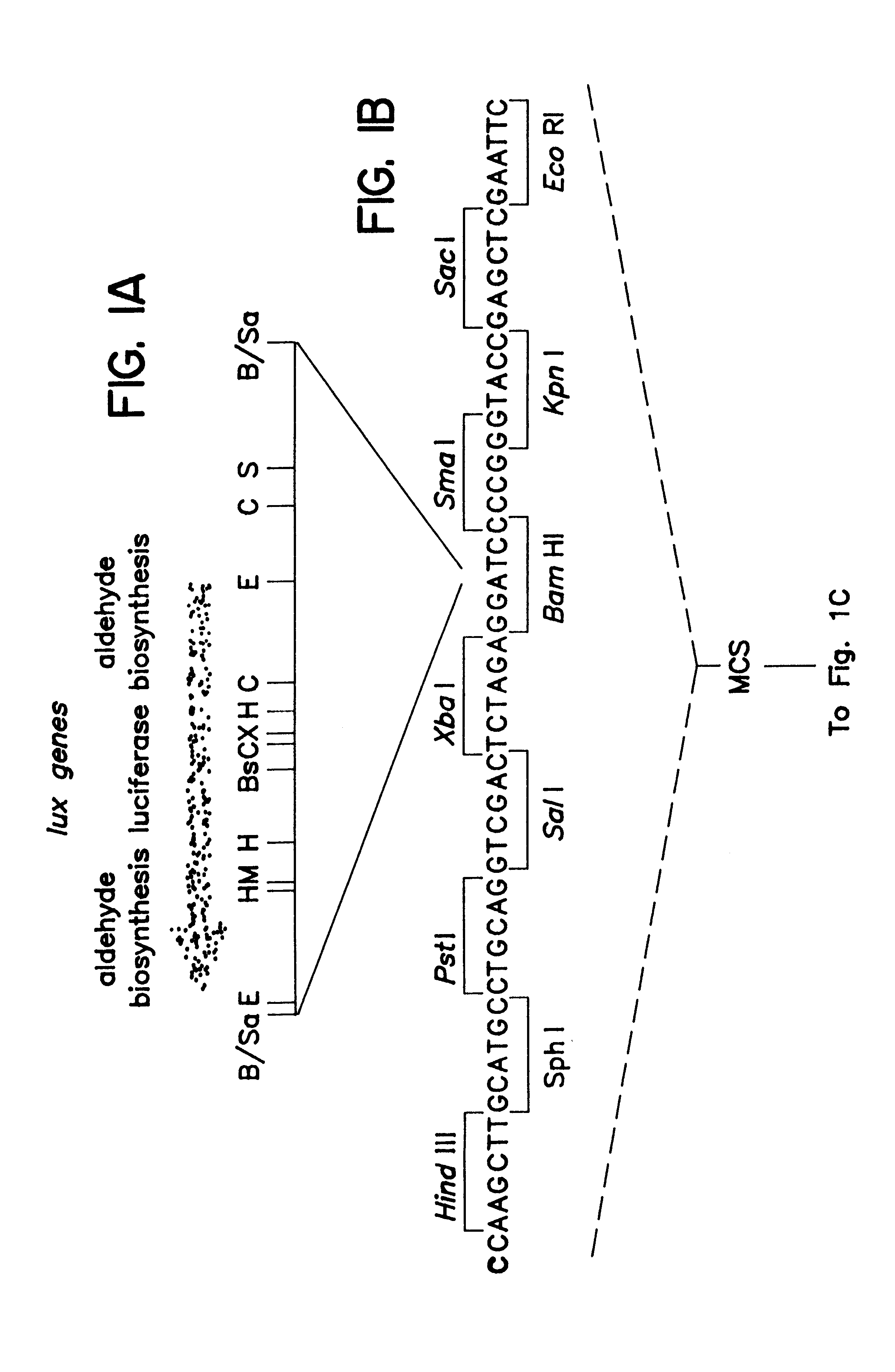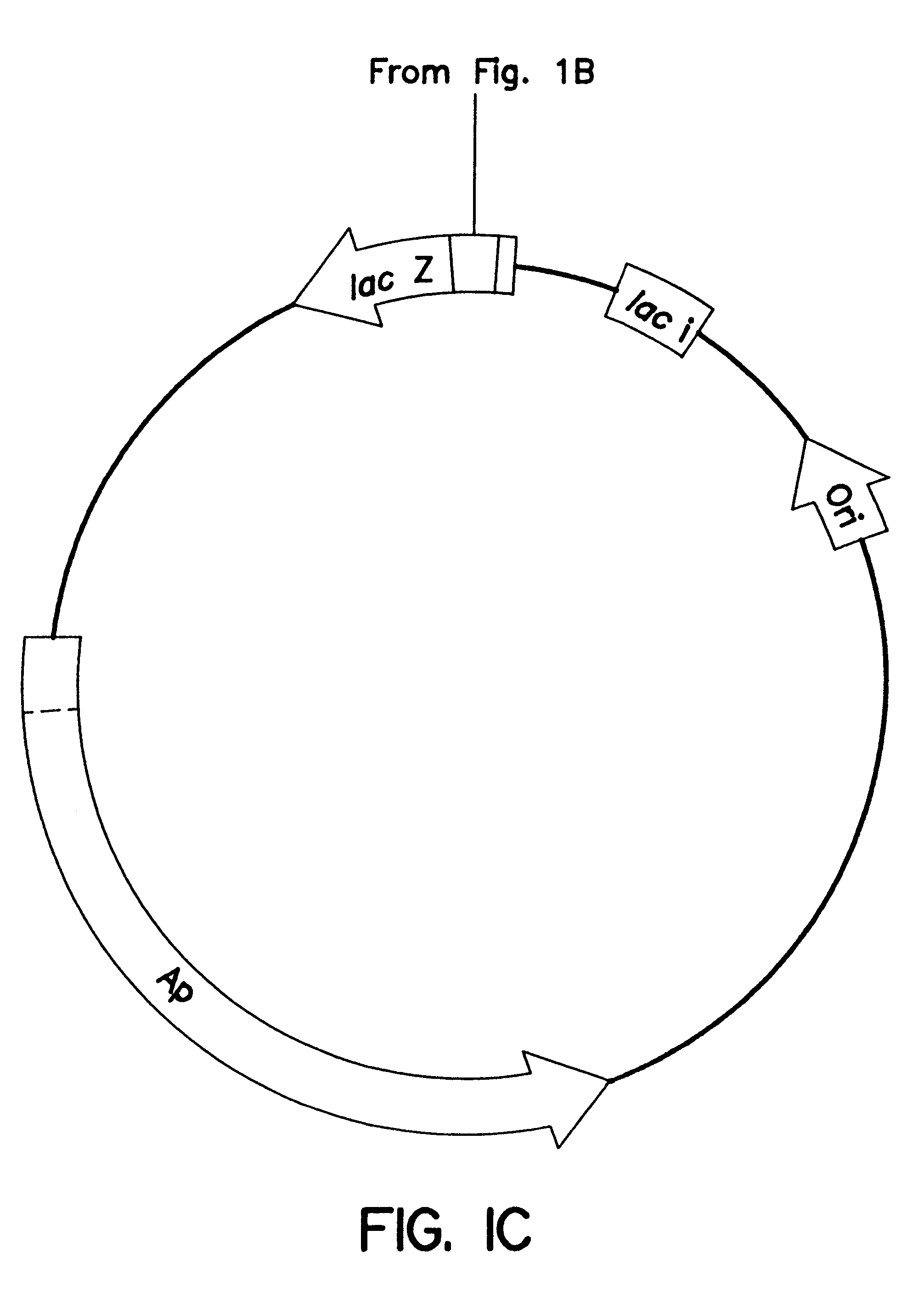Non-invasive localization of a light-emitting conjugate in a mammal
a conjugate and non-invasive technology, applied in the field of non-invasive methods, can solve the problems of limited monitoring of the progression of infectious diseases, and achieve the effect of accurate determination of the concentration of the selected substan
- Summary
- Abstract
- Description
- Claims
- Application Information
AI Technical Summary
Benefits of technology
Problems solved by technology
Method used
Image
Examples
example 1
B. Example 1
Transformation of Salmonella with pCGLS1 lux Plasmid
Salmonella strains SL1344, BJ66 and LB5000 were transformed with pCGLS1, a pUC!8-based vector encoding the lux operon from Xenorhabdus luminescens (Frackman, et al., 1993).
1. pCGLS1 Plasmid
A schematic of the pCGLS1 plasmid is shown in FIGS. 1A, 1B and 1C. The plasmid was constructed by cloning an .about.11 kb region encoding the lux genes from the soil bacterium Xenorhabdus luminescens (FIG. 1A; Frackman, et al., 1990) into the Bam HI site (FIG. 1B) of pUC18 (FIG. 1C; Clontech, Palo Alto, Calif.). The construction of the vector is described by Frackman, et al., (1990).
Restriction enzyme sites in FIG. 1A are represented as follows: Bs, Bst EII; C, Cla I; E, Eco RI; H, Hind III; M, Mlu I; S, Sca I; X, Xba I; B / Sa, Bam HI and Sau 3A junction. A sequence included in the multiple cloning site (MCS) is provided in FIG. 1B, with the Bam HI site indicated in bold type.
A graphical representation of a pUC18 vector with no insert ...
example 2
C. Example 2
Invasive Potential Of Normal And Transformed Salmonella
The invasive potential of six strains of Salmonella (SL1344lux, LB5000lux, BJ66lux, SL1344, LB5000 and BJ66) was determined using two types of bacterial adherence and entry assays. Colony-forming units (CFU) assays were performed essentially as previously described (Finlay and Falkow, 1989, Mol. Microbiol. 3:1833-1841) with modifications (Lee, et al., 1990, PNAS 87:4304-4308). Bioluminescence assays were performed essentially like the CFU assays, except that the number of cells was quantitated using bioluminescence, as opposed to CFUs.
Briefly, HEp-2 cells and primary murine peritoneal macrophages were seeded into 24-well tissue culture dishes at 1.times.10.sup.5 cells per well in RPMI (Gibco / BRL, Grand Island, N.Y.) supplemented with 20 mM glutamine (Gibco / BRL) and 5 fetal calf serum (Hyclone, Logan, Utah). Twenty four hours (HEp-2) or seven days (macrophages) after cell seeding, bacteria from static cultures (see "M...
example 3
D. Example 3
In vitro Luminescence of Transformed Salmonella
10 .mu.l of four 10-fold serial dilutions (ranging from 10.sup.6 cells to 10.sup.3 cells per ml) of LB5000lux Salmonella were placed in four 100 .mu.l glass capillary tubes (Clay-Adams div. of Becton Dickinson, Parsippany, N.J.). The bacterial suspensions formed columns of fluid in the tubes, with pockets of air at both ends. One end of each tube was sealed with critoseal (Clay-Adams). The medium in which dilutions were made was saturated with O.sub.2 through exposure to air.
The tubes were wrapped with clear plastic wrap and luminescence was determined by imaging for 30 seconds as described above. An exemplary image is shown in FIG. 3A. Four tubes are pictured. They contained (from top to bottom) 10.sup.6, 10.sup.5, 10.sup.4 and 10.sup.3 Salmonella cells / ml (10.sup.4, 10.sup.3, 10.sup.2 and 10 cells / tube). Luminescence could be detected in suspensions containing as few as 10.sup.4 cells / ml (100 cells). The luminescence is co...
PUM
| Property | Measurement | Unit |
|---|---|---|
| wavelength | aaaaa | aaaaa |
| wavelength | aaaaa | aaaaa |
| wavelengths | aaaaa | aaaaa |
Abstract
Description
Claims
Application Information
 Login to View More
Login to View More - R&D
- Intellectual Property
- Life Sciences
- Materials
- Tech Scout
- Unparalleled Data Quality
- Higher Quality Content
- 60% Fewer Hallucinations
Browse by: Latest US Patents, China's latest patents, Technical Efficacy Thesaurus, Application Domain, Technology Topic, Popular Technical Reports.
© 2025 PatSnap. All rights reserved.Legal|Privacy policy|Modern Slavery Act Transparency Statement|Sitemap|About US| Contact US: help@patsnap.com


